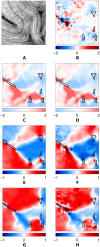Physically informed data-driven modeling of active nematics
- PMID: 37406118
- PMCID: PMC10321743
- DOI: 10.1126/sciadv.abq6120
Physically informed data-driven modeling of active nematics
Abstract
A continuum description is essential for understanding a variety of collective phenomena in active matter. However, building quantitative continuum models of active matter from first principles can be extremely challenging due to both the gaps in our knowledge and the complicated structure of nonlinear interactions. Here, we use a physically informed data-driven approach to construct a complete mathematical model of an active nematic from experimental data describing kinesin-driven microtubule bundles confined to an oil-water interface. We find that the structure of the model is similar to the Leslie-Ericksen and Beris-Edwards models, but there are appreciable and important differences. Rather unexpectedly, elastic effects are found to play no role in the experiments considered, with the dynamics controlled entirely by the balance between active stresses and friction stresses.
Figures






References
-
- Toner J., Tu Y., Flocks, herds, and schools: A quantitative theory of flocking. Phys. Rev. E 58, 4828–4858 (1998).
-
- Toner J., Tu Y., Ramaswamy S., Hydrodynamics and phases of flocks. Ann. Phys. Rehabil. Med. 318, 170–244 (2005).
-
- Ramaswamy S., The mechanics and statistics of active matter. Annu. Rev. Condens. Matter Phys. 1, 323–345 (2010).
-
- Marchetti M. C., Joanny J. F., Ramaswamy S., Liverpool T. B., Prost J., Rao M., Simha R. A., Hydrodynamics of soft active matter. Rev. Mod. Phys. 85, 1143–1189 (2013).
-
- Jülicher F., Grill S. W., Salbreux G., Hydrodynamic theory of active matter. Rep. Prog. Phys. 81, 076601 (2018). - PubMed
LinkOut - more resources
Full Text Sources

